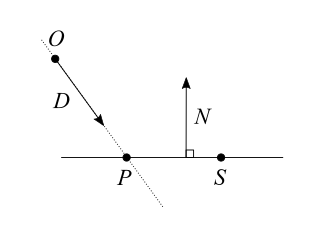I previously showed the derivation of how to determine the intersection of a plane and a cone. At the time I had to solve that equation, so after doing so I decided to publish it for anyone to use. Given the positive feedback, it seems this was useful, so I might as well continue with a few more.
Here is probably the most basic intersection: a ray and a plane. Solving it is straightforward, which I hope can be seen below. Like last time, I am using vector notation.
- We define a ray with its origin
Any point
When - We define a plane with a point
The distance between any point - We define

Since
A question to ask ourselves is: what about the division by
Note: There are several, equivalent, ways of representing a plane. If your plane is not defined by a point
Signed distance to a plane
For the sake of simplicity, in the above we defined the distance to the plane as an absolute value. It is possible however to define it as a signed value:
Distances that can be negative are called signed distances, and they are a foundation of Signed Distance Fields (SDF).


